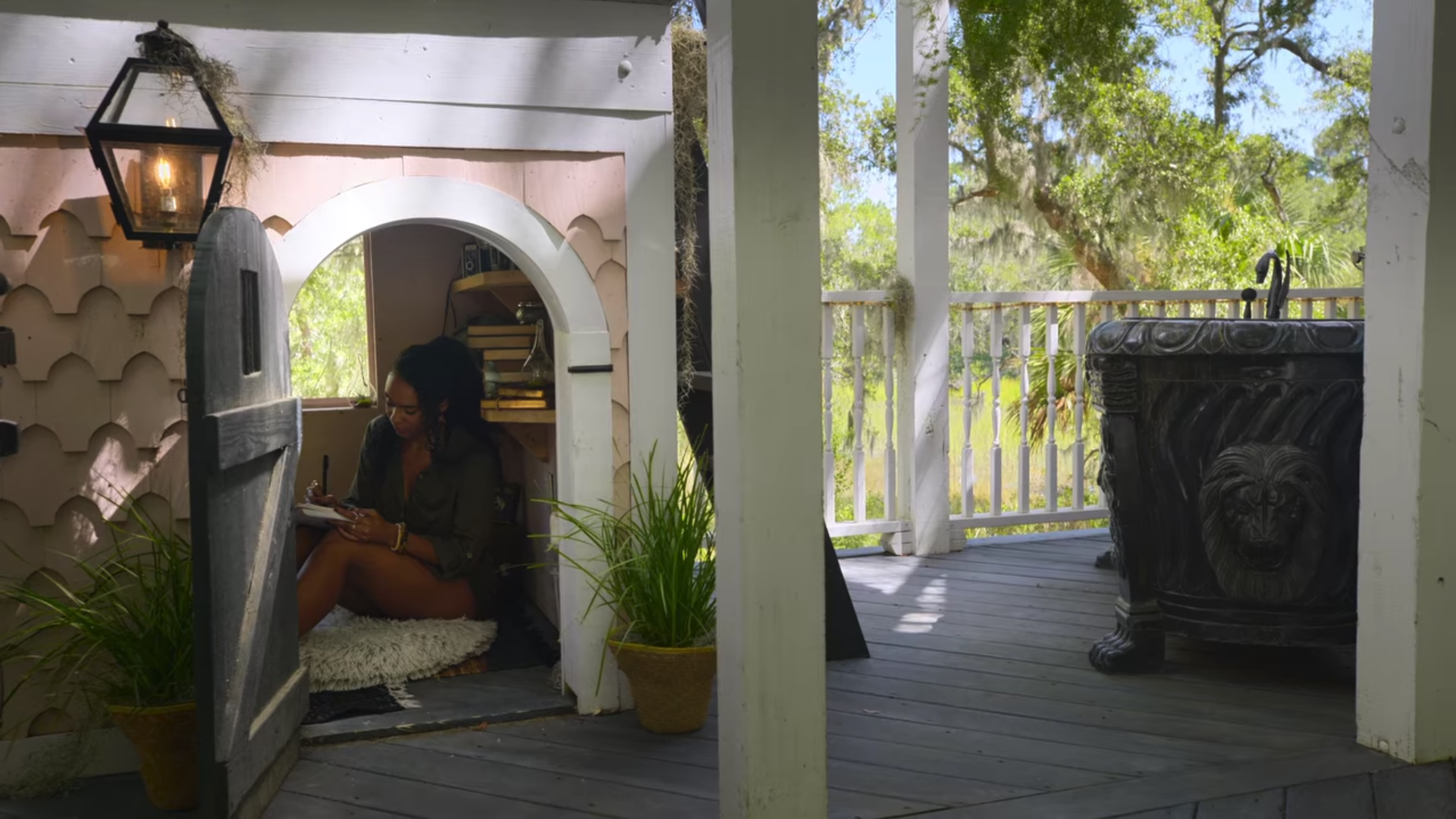Therapeutic Themes From Netflix’s “World's Most Amazing Vacation Rentals”
Courtesy Netflix
Netflix’s series, The World’s Most Amazing Vacation Rentals, released its second season on September 14, 2021. The first season, partially shot during the pandemic, and the second season, shot entirely during the pandemic, captures the essence of the word wanderlust. The adventure, excitement, and discovery allow audiences to open their hearts to travel: something lacking for many during the pandemic. This revived hope that eventually we will be where these three hosts are, traveling the world freely, is what keeps this show on Netflix’s Top 10 list.
Along with allowing us to live vicariously through the hosts of this travel documentary, it also has various other therapeutic benefits - many of which I have shared with my clients. As a Geek Therapist, I will use passions and fandoms to help foster growth and change for my clients. This show touches on the passion to explore, and given its unique format, it is the perfect recipe for psychoeducation. Below are the various ways I have learned to incorporate this show into my practice:
Diversity
Courtesy Netflix
When we travel, we have the opportunity to experience diverse lands and cultures. But this show doesn’t just give diversity through its destination. It provides it with its hosts. All three hosts are People of Color, and even more exciting for viewers is that two of them are women. Though the travel show industry is increasing in its representation of women hosts, it’s still a relatively small representation. The hosts of the shows are Megan Batoon, Jo Franco, and Luis Ortiz. Through the eyes of these three travelers, viewers get to experience exceptional rental properties that meet a variety of budgets and tastes. Each is tasked with a specific theme to help inspire a particular type of traveler.
Batoon is a YouTube content creator, choreographer, dancer and has been called the “Millennial Martha Stewart.” On the show, she is tasked with finding rental properties that are budget-friendly. She doesn’t consider just solo travel in her low-cost finds. She will even consider spaces that may accommodate a large family, which fits close to her values as an American who is half Filipino, a part Irish, and part Polish. On the show, viewers see Batoon caring and cooking for her co-travelers, demonstrating both her caregiving nature and continued budget-conscious mind (it costs less to cook your food on a trip). As she’s also a designer, she will teach viewers about the architecture and style of the rental properties.
Franco is a polyglot (speaking five languages), traveler, businesswoman, writer, and YouTuber. Often, she seeks out properties that are unique, unusual, and inspiring. Having visited over 50 countries, Franco has developed a keen eye for finding the unexpected. She is a Brazilian woman who showcases culture in the mix of each episode. Franco isn’t afraid to immerse herself in the culture she is visiting, have complex discussions about multigenerational trauma, and encourage reverence through various site-specific land acknowledgments. She shows viewers how to appreciate the communities they visit.
The final host, Ortiz, found fame in his profession as a real estate agent. Cohosting the Bravo show Million Dollar Listening New York, it’s no surprise he locates luxurious rentals. Often his finds are expensive, filled with opulence, amenities, and all-inclusive experiences. Of Puerto Rican descent, Ortiz encourages his travel buddies to indulge themselves and embrace pleasure and satisfaction. He highlights the importance of self-care for himself and his associates. He also provides viewers interested in becoming rental property owners with tips and tricks on what makes a successful listing.
For clients, these three diverse travel companions create three distinct personas whom they may model. Their diversity in culture and drive helps provide a blueprint to discuss and celebrate uniqueness and differences. Additionally, it opens the door to a review friend groups and how diverse, supportive, and encouraging these groups are towards being unique and having different passions.
Bonding
Courtesy Netflix
Often one of the goals of group vacations is bonding. This show gives many examples of how the three find ways to bond with each other. They do regular check-ins or partake in a variety of excursions. They slow down to stargaze or playfully discuss the texture of linens. When it comes to accommodations, they will share their food, their products, or sleeping arrangements. They will take turns surprising one another through gifts and experiences. They even encourage each other to try new things while respecting boundaries.
With clients, the idea of sharing can be foreign. When they tune into episodes where the group needs to think like a community: sharing assets, it gives them the example to understand the needs of their fellow travelers. The boundaries the hosts set are also a way for clients to learn boundary setting in their daily lives, such as needing alone time or being able to say ‘no.’ Boundary setting encourages connection through the mutual respect of each other’s space.
This show also provides a real example of platonic friendships between different genders. Too many times, reality TV will push a heteronormative narrative between hosts of the opposite sex. Instead, we see Ortiz laughing, joking, and enjoying his female cohosts. He isn’t pining, courting, flirting, or coercing them. Batoon and Franco also show their comfortableness with being single on these trips. They aren’t finding fulfillment in attempting a romantic relationship with Ortiz. The three of them thoroughly enjoy their platonic relationships and don’t regret not having a partner journey with them.
Friendship travel is as vital as romantic travel. When working with couples, this show is an excellent example of the importance of developing memories with peers alone. It is rejuvenating and inspiring. It allows couples to share stories and seek active constructive communication when they reunite. Moreover, my male clients who are attracted to women often do not have a good representation of what a friendship looks like with a woman. Usually, these clients were not taught the benefits of opposite-sex friendship. They report having difficulty imagining what these friendships would look like and challenging the notion to only view women in terms of romance or sex. This show gives perfect examples of how to have friendships with women and the benefits of these relationships.
Vulnerability
Courtesy Netflix
All three hosts regularly find themselves so awestruck by their surroundings they are moved to tears. None of them shy away from these feelings. They openly cry in front of each other and the camera. They take a moment to feel their feelings. And their companions encourage and support them in emotional expression. They all have subtly agreed that if a moment elicits overwhelming emotions, those emotions should be embraced.
Often, when someone expresses big feelings in reality TV shows, it’s through emotional harm or a response to antics meant to insight embarrassment. The feelings are often depicted as reactive. With this show, emotions are responsive. They are expressed at the moment as part of a holistic response to the current moment. I’ve encouraged clients to take active notice of episodes where we see Batoon, Franco, and Ortiz cry and encourage them to check-in with themselves. Were they also moved to tears? What about moments where the three burst into spontaneous laughter? Could they find themselves giggling along? These moments allow clients to build empathy and find compassion towards their own feelings. These episodes give permission to the audience that, yes, vulnerability is a form of connection -connection to ourselves, others, and the environment.
Cultural Awareness
Courtesy Netflix
When engaging with different cultures, they also acknowledge the history of the places they visit. They have openly discussed with each other - and when there are trip-hosts with them - slavery and colonization. Though they do not go into depths, this level of consciousness is often missed for general travelers who seek destinations for escape only. Instead, Batoon, Franco, and Ortiz encourage audiences to learn that escapism can be integrated with realism.
I will often include clips of these specific moments for clients who want to maintain awareness of social injustices, particularly social inequality and racism. These individuals may find travel difficult, as they struggle with appreciating their destination given current worries of the social-political climate. Our world travelers show us that it’s possible to honor the past, acknowledge the present, and encourage travel that will foster social-political change for the future. This provides context for clients to engage in these conversations with their own travel companions without fearing judgment or ridicule for being “too woke.”
Mindfulness
Courtesy Netflix
Along with recognizing their feelings in the moment, the hosts freely bask in the moment. When they are touring a new rental, if a particular spot moves one of them, they will assert their need to reflect on the space that has grabbed their attention. They don’t rush through the experience. They are mindful and in the present. Their fellow travelers don’t attempt to rush them through the experience. They accept and understand and continue with their own journey. They don’t try to convince each other to stay or go. Instead, they give each other grace to experience the present; however, each of them wants to receive it. They even take time to put distracting objects, like their cellphone or luggage, aside, so they can thoroughly soak in the moment.
Being present is a difficult thing for our society. We are often told to do. We are rarely told to simply be. When it comes to incorporating a mindfulness practice, many clients are not able to find the time. They focus on scheduling a time to be present. When I pull up clips of the gang finding mindfulness in the moment, it’s a great way to teach precisely what mindfulness is: awareness of the moment—not rushing it—not planning it—not expecting it—just allowing it. This usually helps drive this message home to my clients and makes it easier to discover awareness and present being.
Solitude
Courtesy Netflix
The pandemic has increased people’s experience of isolation. Isolation is the state of lacking connections, social relationships, and emotional support. This breeds loneliness. Loneliness is the longing for social contact and bonding. The effects of isolation and loneliness include high risks of stress, heart disease, high blood pressure, depression, anxiety, and low self-esteem. Often it’s difficult for people to see being alone as healthy. They may have limited experience with solitude, the state of intentional rejuvenated seclusion. This show provides plenty of examples of solitude. Some of the benefits of solitude include developing compassion, boosting productivity, cognitive planning, and self-discovery.
First, there are certain episodes where we see individual time cherished and fostered. That individual time often features internal reflection. It can be journaling in a little nook, kayaking alone, playing guitar, or taking in the wonder of unique architecture. They will share the insights they gained in these moments: reclaimed childhood memories, a renewed sense of self-worth, or an instant sensation of belonging. These moments are ideal for showing clients the healing benefits of solitude. They are intentional and experienced without hesitation.
Secondly, none of the hosts pressure “group engagement.” Frequently activities are offered for everyone to enjoy, but no one is required to join. They remove the impression of forced inclusion. Instead, it’s allowed and supported if one group wants to wander off on a different experience. There are even times where all three hosts are engaged in different activities during the trip. These episodes are perfect for helping clients understand the value of having and respecting protected alone-time, especially when traveling with a group. It also removes the belief that a trip isn’t enjoyable unless everyone is doing the same thing all the time.
Lastly, clients can take note of individuality with solitude. Each host finds ways to reconnect with themselves, and these ways are different. Some moments are quiet, while others are energetic. Sometimes the solitude is even individual reflection while still around others. Solitude is meant to be individualized, and this Netflix show provides many opportunities to highlight this. It teaches that there is no “right way” to find self-connection. Only the way that is comfortable for the person engaging in it.
Philanthropy
Courtesy Netflix
In a specific episode in the new season, Giving Back Getaways, our globetrotters find themselves traveling with a philanthropic purpose. The show opens with the trio exploring a horse ranch run by Autistic adults. It’s rare that Neurodiverse individuals are shown in a positive light. Autistic adults are shown with respect from a strength-based lens. Even their lodging is mindful of Autistic needs, with a minimal design that prevents sensory overload. This scene can be used with families of Autistic youth as a way to increases awareness, representation, and foster belief around independent living. The trip gives back by funding the ranch and the Autistic ranchlands.
The show then travels to Mexico to feature a resort that created an art school locals attend, directly financing it. The juxtaposition of the grandeur of the resort in a community that is poverty-driven could be jarring, but the show provides context on the importance of uplifting the community through the financial investment brought about by tourism. Fostering growth in the arts is another added bonus for the locals wanting to learn skills in the artistic trades.
The episode ends with a jaunt to Japan to stay in a home run by a small lumber village. Funds from the stay support the entire community. The collectivist mindset is featured as the lodging hosts are multiple village members, instead of a single property owner. Along with the Mexico resort, these two scenes show the importance of traveling to support smaller communities. The entire episode also drives home traveling with a purpose.
Travel
Courtesy Netflix
The primary therapeutic theme in this show is that of travel. There are many benefits to traveling, such as getting a mental reset, alleviating stress, increasing creativity, and learning to take a new perspective. When we cannot travel due to conflicting schedules, or in this case, an ongoing global pandemic, it’s essential to recapture those feelings. This show provides this opportunity. It cannot replace in-person travel, but it can be an adjunctive way to capture the sense of rejuvenation we desire.
It also shows the subtle importance of sharing the emotional labor of travel planning. Each host has a specific theme they plan for the group - from destination to excursion. Often, especially for families, the burden of planning is placed on one person. This show gives an actual perspective on how sharing labor allows everyone to engage in the trip with equal enjoyment.
Watching this show allows audiences to travel to unexpected destinations. Experiences we did not imagine were vacation rentals. From treehouses and igloos to the belly of a snake; houseboats and haunted dwellings, they’ve got it all. Though we cannot travel as freely as we once did, The World’s Most Amazing Vacation Rentals allows us an opportunity to have a secondary experience with travel. It also prepares us for when we will get back to regular vacationing by giving us a new framework for traveling.
Did you find other therapeutic themes on this show? Do you have travel shows that are teaching you? If so, share in the comments section below.










WEBSITE DISCLAIMER The information provided by Guidance Teletherapy Family Counseling Inc. (“we,” “us,” or" “our”) on https://www.guidancett.com/ (the “Site”) is for general information only. All information on the Site is provided in good faith. However, we make no representation or warranty of any kind, express or implied, regarding the accuracy, adequacy, validity, reliability, availability, or completeness of any information on the Site. Under no circumstance shall we have any liability to you for any loss or damage of any kind incurred as a result of the use of the Site or reliance on any information provided on the Site. Your use of the Site and reliance on any information o the Site is solely at your own risk.
EXTERNAL LINKS DISCLAIMER The Site may contain (or you may be sent through the Site) links to other websites or content belonging to or originating from third parties or links to websites and features in banners or other advertising. Such external links are not investigated, monitored, or checked for accuracy, adequacy, validity, reliability, availability, or completeness by us. We do not warrant, endorse, guarantee, or assume responsibility for the accuracy or reliability of any information offered by third-party websites linked through the Site or any website or feature linked in any banner or other advertising. We will not be a party to or in any way be responsible for monitoring any transaction between you and third-party providers of products or services.
PROFESSIONAL DISCLAIMER The Site cannot and does not contain medical/health/mental health advice. The medical/health/mental health information is provided for general information and educational purposes only. It is not intended as a substitute for professional advice. Accordingly, we encourage you to consult with the appropriate professionals before taking any actions based on such information. You should not use this information to diagnose or treat a mental or medication health condition. The use or reliance of any information contact on the Site is solely at your own risk.
AFFILIATES DISCLAIMER The Site may contain links to affiliate websites, and we receive an affiliate commission for any purchases you make on the affiliate website using such links. We are participants in the Amason Services LLC Associates Program, an affiliate advertising program designed to provide a means for us to earn advertising fees by linking Amazon.com and affiliated websites.